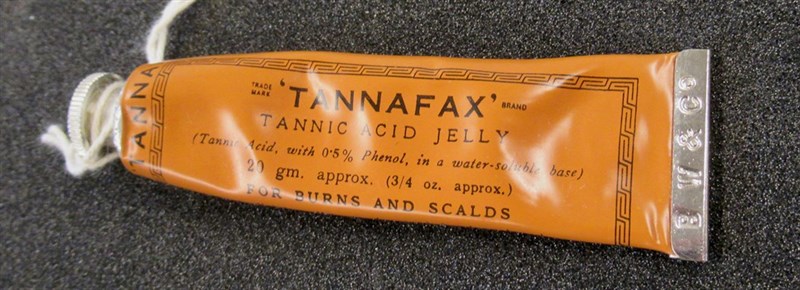Tannafax for Burns
Early Use
Tannic acid was proposed as a topical treatment for burn wounds in 1925 by EC Davidson in Detroit, USA. He applied gauze dressings to burns soaked with 2.5% tannic acid as a means to reduce the previously high mortality rate resulting from really quite small area burns and scalds. It was subsequently proven to reduce mortality by 75% at both the Edinburgh Royal infirmary and Royal Edinburgh Hospital for sick children, by W C Wilson who sprayed it warm onto wounds using a nasal spray atomizer. He became an enthusiastic advocate for its use as a first-aid measure for burns.
It was extensively used throughout the first world war for both thermal and chemical injuries. Applied to a deep burn, it “coagulated” and hardened the tissue into a carapace-like, distinctive black crust known as an “eschar”. By such means it was thought to seal the wound, protecting patients from the otherwise devastating consequences of infection and sepsis, major problems in the pre-antibiotic era.
The BAPRAS Collection’s tube of Tannafax jelly was manufactured in 1940 by Burroughs Wellcome & Co. It is currently on loan to the Hunterian Museum at the Royal College of Surgeons of England.
Used upon superficial and small area burns, it could be peeled away as the tissues healed spontaneously underneath to reveal healed skin. For deeper injuries affecting the full thickness of the skin and sometimes the underlying tissues, healing could not take place quickly. This was an era when Surgery was not considered for burns. Patients with moderate to large area injuries, if they survived at all, we’re dressed for months if not years until healing took place. The coagulation method of burn treatment, was standard.
Use In Wartime
“Tannafax” appeared in 1937 as a tannic acid jelly for ready application to any burn wound, even by the untrained. It’s use became widespread being found in every first-aid bag as well as ambulances and hospitals. It was only really suitable for small areas superficial burns. So when, pilots particularly, began to survive burns to large or significant areas, such as their whole hands and face, Tannafax became overused. It actually made matters worse by reducing further already compromised circulation in the fingers, leading to amputation. When applied to eyelids it wasa even more devastating, causing blindness.
In his book, “Shot Down In Flames” the RAF pilot Geoffrey Page describes looking at his burnt hands for the first time, ‘from the wrist joints to the fingertips they were black…….. I shared the voluntary aid detachment nurses’ expression of horror – “that stuff is only tannic acid. It’s not the colour of your skin”’ Many fingers and eyes were lost before Archibald McIndoe, senior Plastic Surgeon to the RAF in World War II at the Queen Elizabeth Hospital East Grinstead, recognised that widespread use of Tannafax reduced the chances of successful reconstruction and rehabilitation.
Tannafax Banned
 At McIndoe’s insistence, early in the second world war, the War Office set up a committee on burns led by him and Harold Gillies, the father of British Plastic Surgery and the Army’s chief plastic surgeon. Their report in October 1940 warned that Tannafax use on the hands and face was dangerous and should be stopped forthwith. They further recommended tannic acid use for full thickness (third degree) burns was inappropriate and should also be abandoned. Despite this, there was some resistance to stopping its use and to McIndoe himself, by the senior medical community of the time. However, research was stepped up into replacements. Eventually an antiseptic alternative combination of ammonium bromide and sulphanilamide, known as “No. 9 cream” was developed by Colebrook of the Glasgow Royal Infirmary in 1942. A special tube and spreader were devised and put into general use in the armed forces shortly thereafter, effectively replacing “Tannafax”. Its general use faded shortly after.
At McIndoe’s insistence, early in the second world war, the War Office set up a committee on burns led by him and Harold Gillies, the father of British Plastic Surgery and the Army’s chief plastic surgeon. Their report in October 1940 warned that Tannafax use on the hands and face was dangerous and should be stopped forthwith. They further recommended tannic acid use for full thickness (third degree) burns was inappropriate and should also be abandoned. Despite this, there was some resistance to stopping its use and to McIndoe himself, by the senior medical community of the time. However, research was stepped up into replacements. Eventually an antiseptic alternative combination of ammonium bromide and sulphanilamide, known as “No. 9 cream” was developed by Colebrook of the Glasgow Royal Infirmary in 1942. A special tube and spreader were devised and put into general use in the armed forces shortly thereafter, effectively replacing “Tannafax”. Its general use faded shortly after.
Read further information:
https://www.nature.com/articles/125058a0
https://www.ncbi.nlm.nih.gov/pmc/articles/PMC2452459/?page=1
Guinea Pig Club – E Mayhew